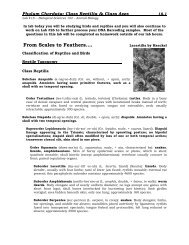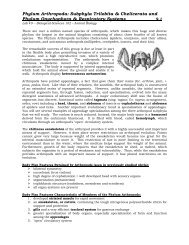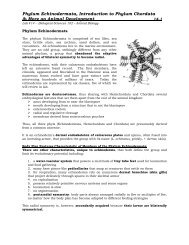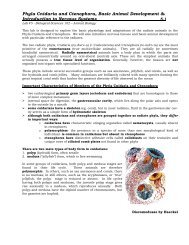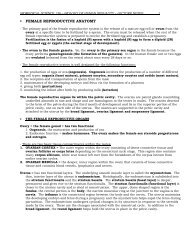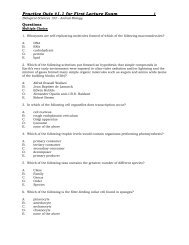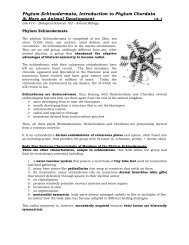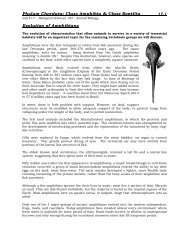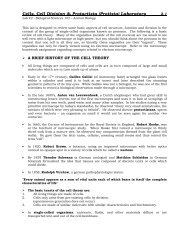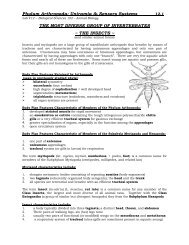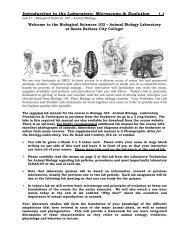Field Survey: Aquatic Insects & the Riparian Habitat - Biosciweb.net
Field Survey: Aquatic Insects & the Riparian Habitat - Biosciweb.net
Field Survey: Aquatic Insects & the Riparian Habitat - Biosciweb.net
You also want an ePaper? Increase the reach of your titles
YUMPU automatically turns print PDFs into web optimized ePapers that Google loves.
<strong>Field</strong> <strong>Survey</strong>: <strong>Aquatic</strong> <strong>Insects</strong> & <strong>the</strong> <strong>Riparian</strong> <strong>Habitat</strong> 13.1Lab #13 - Biological Sciences 102 – Animal BiologyThe goal of this fieldtrip is to examine <strong>the</strong> diversity of insects in a riparian habitat andformulate hypo<strong>the</strong>ses about <strong>the</strong> selective pressures faced by <strong>the</strong>se species and <strong>the</strong>iradaptations for survival in this habitat.We will meet at <strong>the</strong> sign by <strong>the</strong> Rattlesnake Canyon trailhead for your lab to survey <strong>the</strong>diversity of various aquatic insects in a local freshwater stream (riparian) habitat.You will form groups of three to four, with each group taking a couple of dip <strong>net</strong>s, a smallaquarium/tray, and several jars. (The dragonfly naiads and <strong>the</strong> belastomatids need to beseparated from <strong>the</strong> o<strong>the</strong>r specimens, and from each o<strong>the</strong>r. They are aggressive predators.)Each group will select a small pond or similar area. You will be doing a rough census ofabundance as you collect from your area, keeping track of about how many of each speciesis found. Also note where (water surface, water column, benthic habitat, land-water interface,etc.) in <strong>the</strong> area that each species tends to be found.For instance, <strong>the</strong> Hemiptera divide up <strong>the</strong> water column among <strong>the</strong>mselves:‣ Gerrids = abundant on top of <strong>the</strong> water, feed on things that drop onto <strong>the</strong> surface‣ Notonectids = less abundant, swim upside down, feed in <strong>the</strong> upper half of <strong>the</strong> watercolumn and at <strong>the</strong> surface‣ Corixids = relatively rare, swim facing down, feed in <strong>the</strong> lower part of <strong>the</strong> water column,and on <strong>the</strong> bottom‣ Belastomatids = usually only one or two per pond, rest solidly on <strong>the</strong> bottom, feed onanything <strong>the</strong>y want to <strong>the</strong>reLAB PROCEDURENAME:LAB SCORE:On <strong>the</strong> attached pages (use extra paper if you need it), take notes to record <strong>the</strong> following:1. <strong>the</strong> date, time and climate for <strong>the</strong> day you went on <strong>the</strong> fieldtrip2. a brief description of <strong>the</strong> riparian habitat in which you observed animals and anyunusual characteristics of <strong>the</strong> physical environment or habitat you observed3. all observed animal species, <strong>the</strong>ir phylum, class and order (if we studied it) andabundance (if <strong>the</strong>re are many of one group or species indicate general relative abundance). Forbirds, be sure to indicate <strong>the</strong> order.4. <strong>the</strong> specific habitat (sandy shore, rocky intertidal) or part of a habitat (eg. benthic) inwhich you observed each speciesThe write-up below will count for additional points and a distance learning assignmentfor <strong>the</strong> course.
<strong>Field</strong> <strong>Survey</strong>: <strong>Aquatic</strong> <strong>Insects</strong> & <strong>the</strong> <strong>Riparian</strong> <strong>Habitat</strong> 13.2Lab #13 - Biological Sciences 102 – Animal BiologyAfter you have completed <strong>the</strong> trip, write up your observations in a concise formaccording to <strong>the</strong> following guidelines:YOU MUST ANSWER THE QUESTIONS INDICATED IN THE DISTANCE LEARNINGASSIGNMENT ON THE WEBSITE.This report must be submitted no later than <strong>the</strong> due date indicated on <strong>the</strong> coursewebsite.You may wish to refer to exercise #15 in <strong>the</strong> Hickman lab manual on insects.Use <strong>the</strong> last few pages of <strong>the</strong> lab and extra paper provided to describe and/or quicklysketch <strong>the</strong> various species that you find.‣ Use <strong>the</strong> guide pages and line drawings of insects distributed in lab for reference.‣ Identify insects to <strong>the</strong> level of ORDER.OBSERVATIONAL NOTES:
<strong>Field</strong> <strong>Survey</strong>: <strong>Aquatic</strong> <strong>Insects</strong> & <strong>the</strong> <strong>Riparian</strong> <strong>Habitat</strong> 13.3Lab #13 - Biological Sciences 102 – Animal BiologyOBSERVATIONAL NOTES:
<strong>Field</strong> <strong>Survey</strong>: <strong>Aquatic</strong> <strong>Insects</strong> & <strong>the</strong> <strong>Riparian</strong> <strong>Habitat</strong> 13.4Lab #13 - Biological Sciences 102 – Animal BiologyOBSERVATIONAL NOTES:



